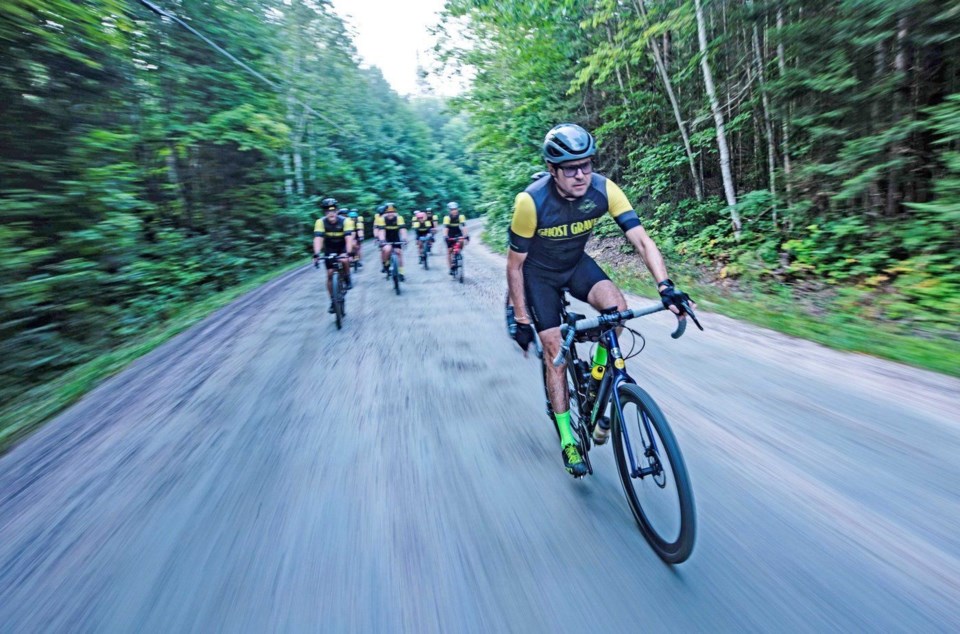The main organizer of a major cycling event planned for Magnetawan in 2022 says a trial run of the upcoming event was an unqualified success.
Matt Foulk had originally planned to hold the Ghost Gravel ride this past August but the persistence of COVID-19 forced him to postpone the event until next summer.
However, delaying the ride worked out in Foulk's favour as he decided to hold a trial run of what cyclists can expect next year.
“It was fantastic and it couldn't have gone better,” Foulk said.
“I'm excited about what's to come. We picked up a lot of valuable experience.”
Foulk, who lives in Toronto, reached out to 14 experienced cyclists around the province to join him in the trial run, which took the group of 15 through 140 kilometres of trails in the Almaguin Highlands, including the Old Nipissing Road.
The ride started and ended in Magnetawan as it followed a circular route.
The 15 riders who tested the Ghost Gravel route in Almaguin started their 140-kilometre trek under misty, foggy conditions in Magnetawan. Organizer Matt Foulk said the look was just what he wanted to give the cyclists a feel of what to expect on one of Ontario's ghost roads.
The experimental run took place on a hot, humid Saturday on Aug. 21. After compiling feedback from the riders, Foulk has now started to release information on what they experienced and what next year's cyclists can expect.
Foulk says the heat that late in August was unexpected – the temperature was 33 C, but combined with the humidity felt like 39 C.
The 2022 ride is expected to take place around the same time in August, and Foulk said running into the unexpected heat means organizers will have an additional water stop along the route in case it's needed.
Foulk says a piece of really good news is that no one got hurt anywhere along the route.
The route the Ghost Gravel follows is considered one of Ontario's ghost roads because it's dotted with abandoned log cabins built by early settlers and weathered barns.
Depending where the cyclists are at any one point, the riding surface ranges from hard- and soft-packed gravel to asphalt as they approach and go through the small Almaguin communities.
Foulk says the riders found the trail to be “definitely unique,” adding “the landscape felt rural and wild.”
He says they were amazed to see the abandoned cabins and structures along the way.
The Old Nipissing Road makes up about one-quarter of the entire route and Foulk said, “It was the most technical and challenging part of the course.”
One reason for this is the rock outcrops and sand the cyclists ran into. The area also is rugged enough that some have to walk rather than ride their bikes.
Foulk said the reaction and feedback from the riders hit the mark on what he's trying to achieve with next year's event.
“I'm hoping to fascinate people with the scenery, history and natural beauty of the area,” he said.
“So it was very fitting that one of the photographs taken of us as we started off in the early morning had low-lying fog. It felt very atmospheric and magical.”
Foulk says the cyclists gave high marks on the organization of the trial run, how welcoming the community was to them and the support from local and area businesses who were able to accommodate their needs along the route. That included support from local and area fire departments, as well as Parry Sound Bikes, which remained on hand to fix mechanical breakdowns.
The trial run showed Foulk there's value in introducing staggered start times in next year's event.
“The 15 of us stayed together on the trial run but you could tell there were some who wanted to race it and others who just wanted to take a more leisurely ride.”
Foulk expects to have the riders staggered into three or four groups, but that decision also will result in another change.
The original plan, had the event taken place this year, included one course length at 80 kilometres and a second at 150 kilometres, with everyone starting off at the same time.
But Foulk says he will likely settle on one length of 140 kilometres.
He says this way, cyclists who want to race can be in one group. Staggering the start times also opens up the possibility of allowing more riders in the event, since there will be plenty of distance between cyclists.
Of the 15 riders, five were women, which Foulk calls a positive development because getting more women involved in this kind of cycling event “is an ongoing challenge.”
Foulk says registrations for next year's Ghost Gravel will likely open next February or March.
The plan between now and next August is to involve more local and area businesses.
The ride itself will still take place over one day, but Foulk is open to the idea of turning the event into a weekend, festive occasion for participants and the public.
He will also have to go back before Magnetawan town council for permission to carry out the Ghost Gravel event.
Two major elements Foulk still has to work out are determining an appropriate entry fee for the cyclists, in order to cover the costs of what has been classified as a premium event, and where to cap the number of participants.
“That's going to be a fine line,” he said.
“We want a lot of people to be able to take part in it, but we also don't want to dilute the experience.”
Rocco Frangione is a Local Journalism Initiative reporter who works out of the North Bay Nugget. The Local Journalism Initiative is funded by the Government of Canada.



